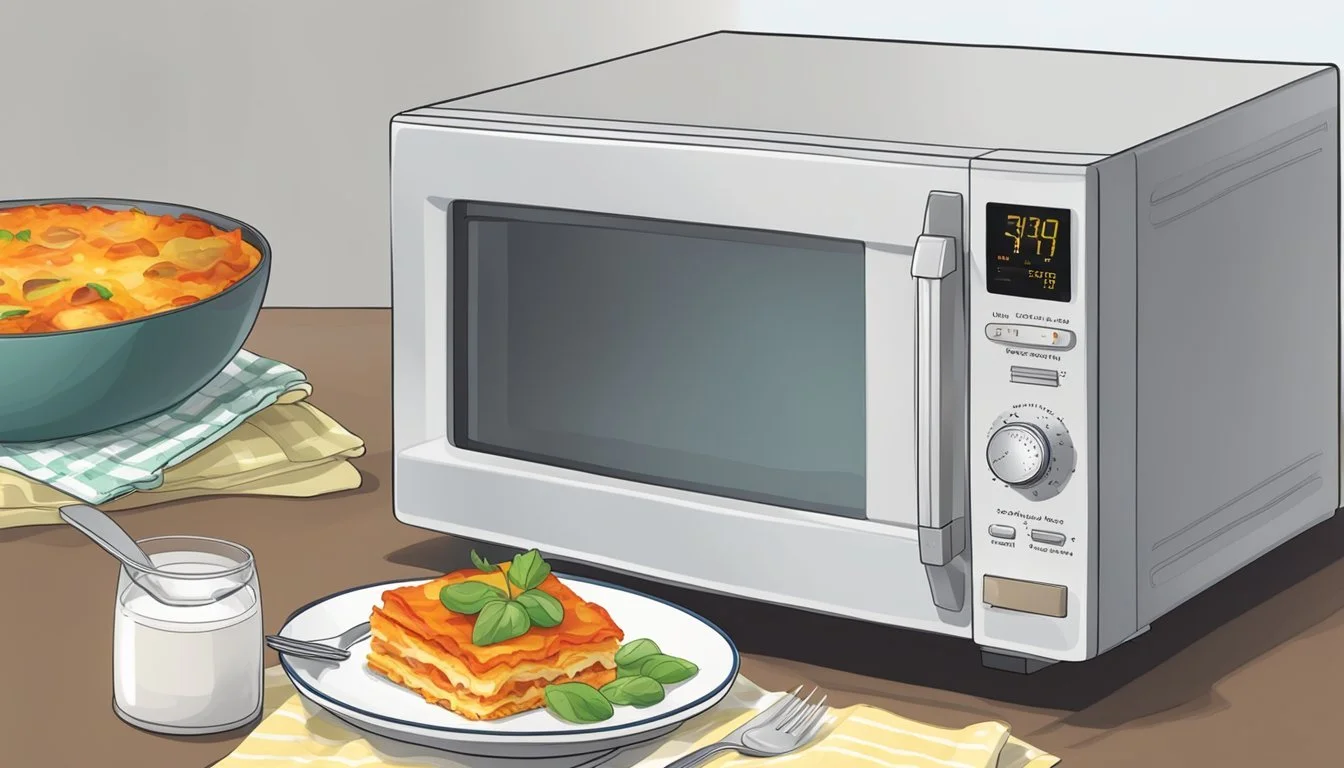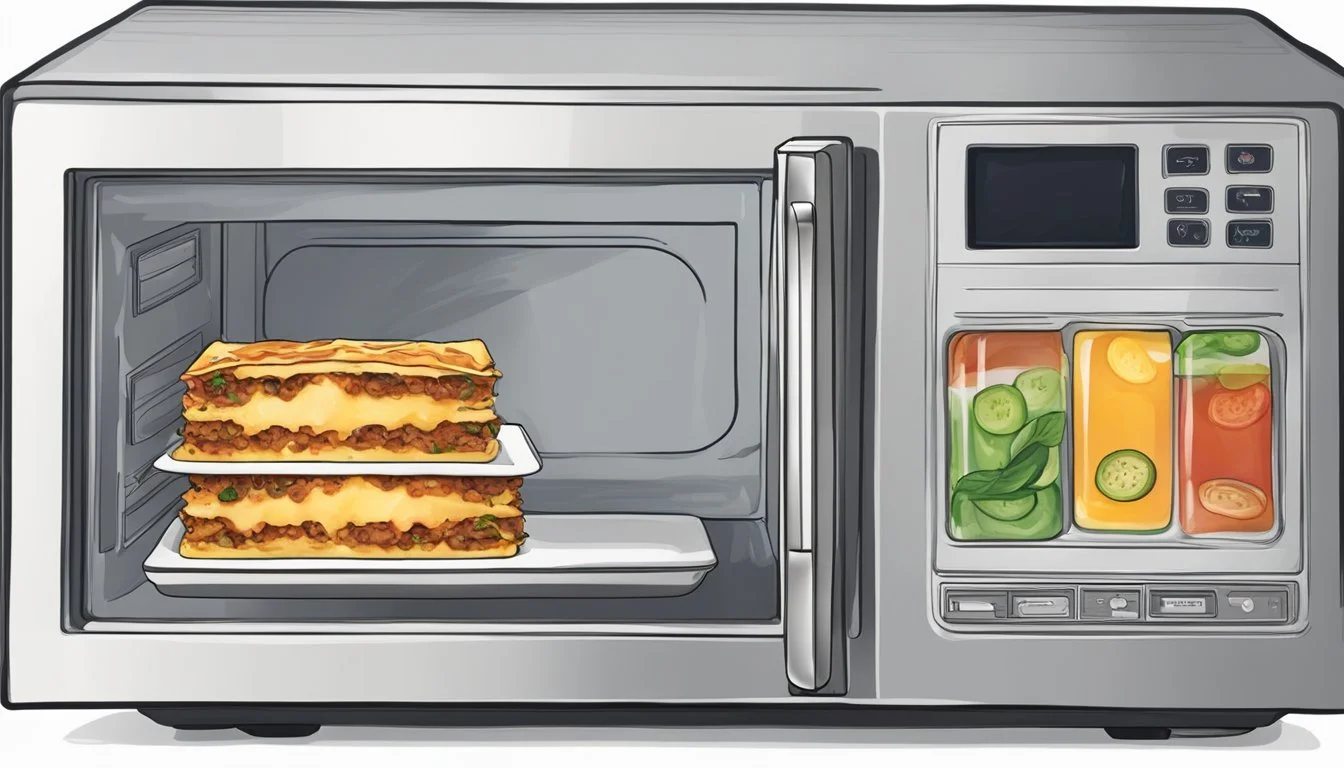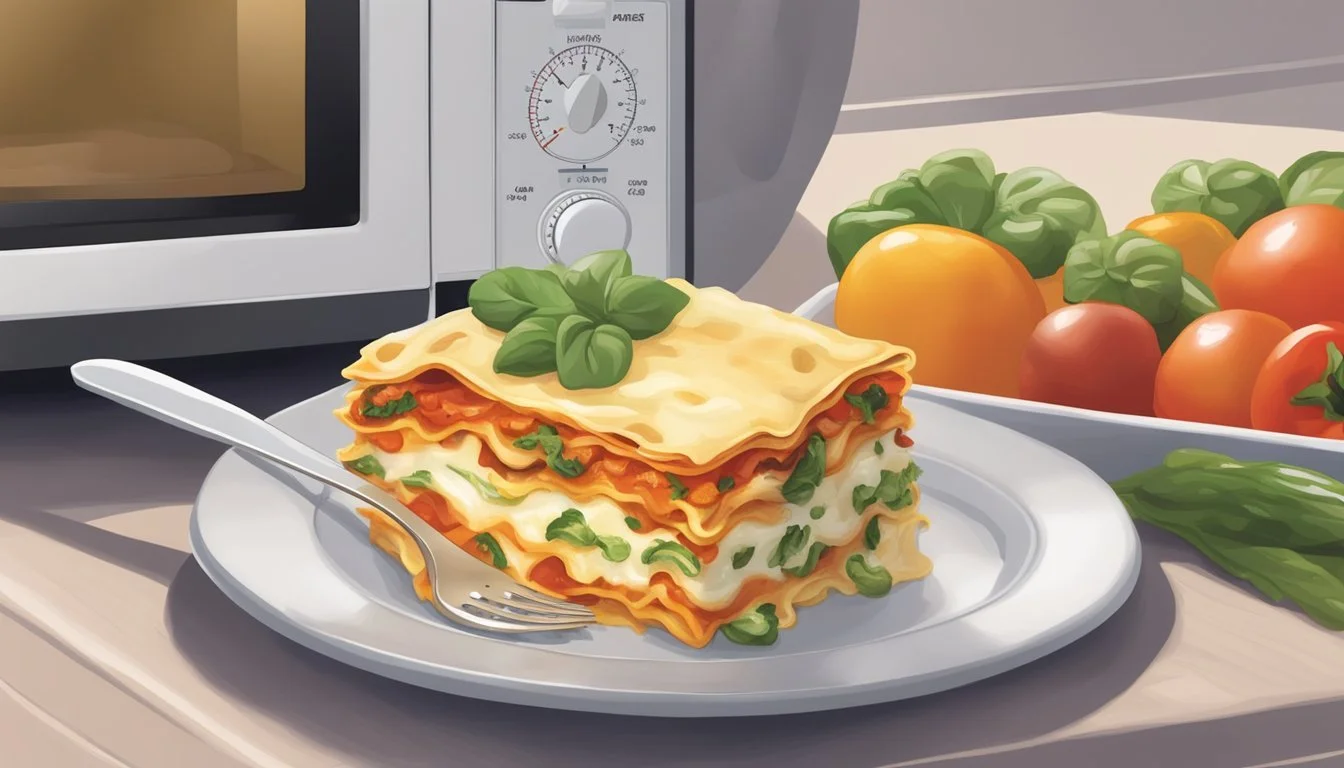How to Reheat Amy's Vegetable Lasagna
Expert Tips for Perfect Warm-Up
Reheating Amy's Vegetable Lasagna can be a convenient way to enjoy a delicious meal without the hassle of starting from scratch. Whether it's leftovers or straight from the fridge, getting it just right is key to retaining its flavor and texture. The best way to reheat Amy's Vegetable Lasagna is by using an oven preheated to 350°F (175°C), covering it with foil to keep it moist, and heating it for 20-30 minutes.
Microwaving is another popular method for those in a hurry. Simply place the lasagna in a microwave-safe dish, add a splash of water, cover, and heat on medium for about 5-6 minutes. Checking and stirring halfway through ensures even heating.
For a crispier option, consider using a skillet. Heat the lasagna on medium-low and cover it, allowing it to simmer for 20 minutes with occasional shaking of the pan. Removing the cover briefly at the end can help achieve a perfect crust.
Understanding Vegetable Lasagna
Vegetable lasagna is a delightful, layered dish that combines various vegetables, cheeses, and pasta, providing a nutritious and flavorful meal. This section will cover its components, texture and cheese aspects, health information, and the critical importance of proper reheating.
Components of Vegetable Lasagna
Vegetable lasagna typically includes layers of pasta, vegetables, and cheese, all brought together with a savory sauce. Key ingredients often include spinach, zucchini, carrots, and mushrooms.
The pasta acts as a firm base, while the variety of vegetables adds texture and nutritional value.
Ricotta, mozzarella, and sometimes Parmesan cheese are spread between the layers, creating a rich and creamy consistency. In addition, the use of fresh, sun-ripened tomato-based sauce helps to bind the layers and enhance the flavors.
Texture and Cheese Considerations
The texture of vegetable lasagna is a crucial aspect that significantly affects its appeal. The cheese should be melted and gooey, while the pasta maintains a firm yet tender bite. Ricotta provides a creamy texture, mozzarella adds a stretchy, melty component, and Parmesan offers a sharp flavor.
The vegetables should be cooked until tender but not mushy. Properly cooking and layering the vegetables ensures that they retain some bite, preventing the lasagna from becoming too liquidy.
Mushrooms, zucchini, and carrots each contribute distinct textures and should be adequately sautéed before layering to deepen their flavors and ensure they cook evenly within the lasagna.
Health and Dietary Information
Vegetable lasagna is an excellent option for those seeking a healthier alternative to traditional meat lasagna. It can be made vegetarian, gluten-free, or dairy-free to accommodate various dietary restrictions.
Using a variety of vegetables not only increases its vitamin and mineral content but also makes the dish lower in calories and fat. Protein content can be enhanced by adding ricotta cheese or incorporating other plant-based protein sources, such as lentils or tofu.
For dietary needs like gluten-free, substitutes such as gluten-free pasta or vegetable sheets can be used. Similarly, dairy-free options involve replacing regular cheese with dairy-free cheese alternatives.
The Importance of Proper Reheating
Proper reheating of vegetable lasagna is essential to preserve its texture and flavor. Leftovers should be stored in an airtight container in the refrigerator. When ready to reheat, it's important to ensure the lasagna is heated through without drying out.
The oven is often the best method for reheating. Preheat to 350°F (175°C), place the lasagna in an oven-safe dish, add a splash of water for moisture, and cover with foil. Heat for about 20-30 minutes, removing the foil in the last 5 minutes for a bubbly top.
Using a meat thermometer, verify that the internal temperature reaches 165°F, a safe temperature for leftovers as recommended by the USDA. This ensures the lasagna is hot and safe to eat, maintaining its quality and taste.
Pre-Reheating Steps
Proper storage, portioning, and preparation are vital for reheating Amy's Vegetable Lasagna effectively. These steps ensure the lasagna retains its flavor and texture.
Storage and Handling of Leftovers
Store the leftover lasagna in an airtight container. This keeps it fresh while avoiding moisture loss. Place the container in the refrigerator promptly, ideally within two hours of cooking, to reduce the risk of bacterial growth.
For longer storage, you can freeze the lasagna. Ensure to label the container with the date to track freshness. Amy's branded lasagna, known for its organic ingredients, requires careful handling to maintain quality.
Determining Portions and Servings
Before reheating, decide on the number of servings needed. Cut the lasagna into individual portions if it was stored as a whole. This ensures even reheating and prevents overcooking.
Individual servings typically take less time to reheat than a full dish. Smaller portions can be reheated more conveniently in a microwave. Keep servings size consistent for uniform reheating results.
Preparations Before Reheating
Remove the lasagna from the refrigerator and let it sit at room temperature for about 10-15 minutes. This step helps the lasagna reheat more evenly.
Preheat your oven to 375°F if you choose the oven method. Place the lasagna in an oven-safe dish, add a few tablespoons of water or sauce to retain moisture, and cover it tightly with aluminum foil. This prevents drying out during reheating.
Reheating Methods Overview
When reheating Amy's Vegetable Lasagna, choosing the right method matters for preserving flavor and texture. Each reheating technique requires specific steps to ensure the lasagna remains moist and delicious.
Oven Reheating Technique
Preheat the oven to 350°F (175°C). Place the lasagna in an oven-safe baking dish. Add 1-2 tablespoons of filtered water or extra virgin olive oil around the lasagna to maintain moisture.
Cover it with aluminum foil. This prevents the top from drying out. Bake for 20-30 minutes until thoroughly heated. To achieve a bubbly top, remove the foil for the last 5 minutes of baking.
Ensure the internal temperature reaches 165°F (74°C) for safe consumption. Let it sit briefly before serving to allow flavors to meld.
Microwave Reheating Approach
Place a slice of lasagna in a microwave-safe dish. Add a small amount of filtered water or extra tomato sauce to maintain moisture. Cover the dish to trap steam.
Heat on medium settings in 1-minute intervals until the lasagna is warm throughout. Be careful to avoid overheating, which could dry out the lasagna noodles.
Check the temperature and stir any sauce and lasagna layers to ensure even heating. This method is quick and convenient for those short on time.
Stove Top Warming Method
Use a skillet to reheat the lasagna. Add a bit of water or extra tomato sauce to the skillet to prevent sticking and to keep the lasagna moist.
Place the lasagna in the skillet and cover with a lid, reducing heat to medium-low. Reheat for about 20 minutes, shaking the pan occasionally to avoid sticking.
For crispier edges, remove the lid for the last 5 minutes of cooking. This method allows for a moist interior with a slight crispiness from the noodles.
Each method ensures Amy's Vegetable Lasagna is reheated to perfection, giving you a meal that retains its original flavor and texture.
Enhancing Flavor Post-Reheat
To elevate the flavors after reheating Amy's Vegetable Lasagna, consider adding fresh ingredients and pairing the dish with complementary side dishes. These steps can transform your lasagna into a more flavorful and satisfying meal.
Adding Fresh Ingredients
Adding fresh basil, seasonings, and black pepper after reheating can breathe new life into the lasagna. Tear fresh basil leaves into small pieces and sprinkle them over the top to add a burst of herbal freshness.
Drizzle a bit of olive oil for added richness. Salt and sea salt can enhance the existing flavors, and a dash of black pepper can add a mild kick. Sautéing some garlic and onions and mixing them into the reheated lasagna can introduce new depths of flavor. Incorporating these ingredients can take the reheated dish to a new gastronomic level.
Complementary Side Dishes
Pairing Amy's Vegetable Lasagna with the right sides can further enhance your meal. A simple green salad with a light vinaigrette can balance the richness of the lasagna. Use fresh vegetables like cucumber, tomatoes, and leafy greens.
Bread can also complement the lasagna well. Consider garlic bread or a crispy baguette. The bread can provide a satisfying crunch alongside the cheesy, gooey pasta. Sautéed or simmered vegetables seasoned with salt, pepper, and spices can also make excellent side dishes, rounding out the meal nicely and providing a variety of textures and flavors.
Serving and Presentation Tips
For a polished look, start by cutting the lasagna into neat, even squares. Use a sharp knife for clean lines.
Serve on white plates to make the colorful veggies and creamy cheese pop.
Add a sprinkle of fresh basil or parsley on top for a burst of color and freshness.
Cheesy Goals: To enhance the presentation, drizzle a bit of extra melted cheese over the lasagna just before serving. This creates an enticing, gooey texture.
For those perfect Instagram moments, wipe the edges of the plate to keep them clean.
When serving, provide a side salad with a light vinaigrette. This balances the richness of the lasagna.
Label each serving for guests with dietary restrictions.
Lasagna is a comfort food, so consider pairing it with a hearty garlic bread. Arrange the bread around the lasagna on the plate for a rustic touch.
Suggested Serving Sizes
Servings Lasagna Size 1 A small, single portion 4 A quarter of the lasagna 6-8 An eighth of the lasagna
Using these tips will help present Amy's Vegetable Lasagna attractively and make it more enjoyable for everyone.
Safety Considerations
When reheating Amy's Vegetable Lasagna, ensuring it reaches the proper temperature is critical. The USDA recommends that leftovers be heated to an internal temperature of 165°F (74°C) to kill any potential bacteria.
Use a food thermometer to verify the temperature. Insert the thermometer into the thickest part of the lasagna for the most accurate reading.
Labeling leftovers with the date they were initially cooked is essential. Vegetable lasagna should be eaten within 3-5 days of refrigeration to minimize the risk of spoilage.
Reheating lasagna multiple times can degrade its quality. Limit reheating to once to maintain both texture and taste.
Consider covering the lasagna with a lid or aluminum foil during reheating to retain moisture and ensure even heating throughout.
Conclusion
Reheating Amy's Vegetable Lasagna can be a straightforward process if done correctly.
For best results, utilize the oven method. Preheat your oven to 350°F (175°C). Place the lasagna in an oven-safe dish and cover with aluminum foil to retain moisture. Heat for 20-25 minutes, or until it reaches an internal temperature of 165°F.
Microwaving is also an option. Place a portion on a microwave-safe plate, cover with a microwave-safe lid or another plate. Heat on high for 2-3 minutes, checking halfway through. This method preserves the lasagna’s texture and flavors.
For those seeking a quick fix, using a stovetop skillet can be effective. Place the lasagna slice in a skillet over medium heat with a splash of water, cover, and heat for about 10 minutes.
These methods ensure that Amy's Vegetable Lasagna remains delicious every time it is reheated. Enjoy the satisfaction of a meal that tastes just as good the second time around.
Sharing and Engagement
Connecting with our readers is important. Here are ways to get involved with our community and stay updated on the latest tips and recipes.
Engage with Us on Social Media
Social media platforms are a great way to share your reheating results and get tips from fellow food enthusiasts. Facebook, Pinterest, and Instagram are the main platforms where we interact with our audience.
Facebook: Follow our page for new posts, cooking tips, and discussions. Share your own reheated lasagna photos and join the conversation in the comments section.
Pinterest: Pin our recipes to your boards and discover new ways to enjoy Amy’s Vegetable Lasagna. You can also find other relevant kitchen tips.
Instagram: Tag us in your posts and use specific hashtags so we can see how you're using our tips. Engage with our stories and participate in polls and Q&A sessions.
Subscribe for More Tips
Subscribing to our newsletter ensures that you never miss out on the latest cooking hacks and exclusive recipes. Here’s what you can expect as a subscriber:
Exclusive Content: Get access to special tutorials and recipes not available elsewhere.
Early Access: Be the first to know about upcoming features and updates.
Weekly Roundup: Receive a curated list of tips, tricks, and reader stories.
Simply enter your email address on our website to join. Engage with our community and enhance your culinary skills!








